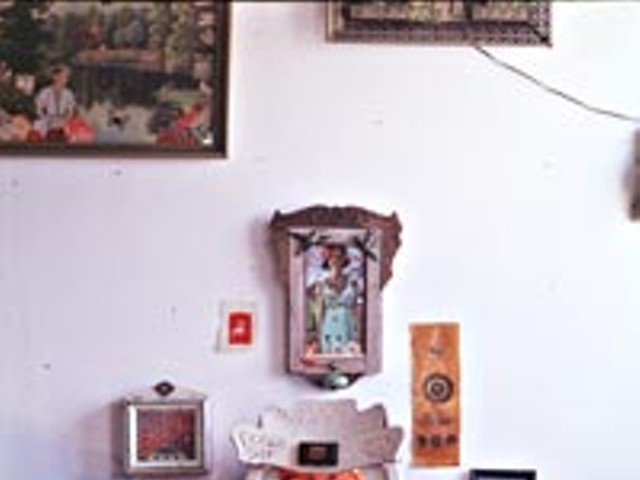Folks of all ages poured into the Detroit Institute of Arts last Sunday to see the new Edgar Degas exhibit; more than 1,600 came on the show’s opening day for the general public, 250,000 more are expected in the next three months.
Major exhibitions are one sure way to generate revenue for the nearly 120-year old museum, which has struggled financially in recent years. But DIA administrators say that they need more than a French impressionist to stay economically viable. Like other arts administrators in metro Detroit, they say they need Oakland and Wayne county voters to pass a regional tax, Proposal K, this Nov. 5.
The roots of the tax go back more than a decade. When Gov. John Engler took office in 1991, he dramatically reduced state arts funding. The DIA, for instance, lost 40 percent of its state dollars, forcing cuts to hours and staff. In response, a coalition formed around Detroit Renaissance in 1994 to push for a regional tax for major institutions like the DIA and Music Hall, as well as community arts and recreational programs. The group argues that a regional tax makes sense since Detroit hosts many cultural institutions while much of the audience and tax base has moved to the suburbs.
“That is such a clear-cut and persuasive argument for regional support,” says Betty Buss, Detroit Renaissance policy director.
Critics say that the public is taxed enough; that roads, sewers and the like should take priority; and that individuals shouldn’t be forced to support arts and recreation programs they may never use. Though there has been no organized opposition to Proposal K — as there was to a similar proposal that was narrowly defeated in 2000 — proponents are only cautiously optimistic about victory on Election Day.
Success elsewhere
Proposal K asks Oakland and Wayne county voters to levy a half mill property tax for 10 years (about $25 annually for a $100,000 home) to pay for cultural institutions and community arts and recreational programs. If passed, the tax is expected to generate $46 million in 2003.
Two-thirds of the revenue will go to operating costs of 17 major institutions such as the Detroit Zoo, WTVS and Meadow Brook Theatre. Each would receive up to 20 percent of their average operating budget for a three-year period. The DIA, Detroit Zoo, Detroit Symphony Orchestra and Henry Ford Museum & Greenfield Village would be capped at $4 million; the others would receive $150,000 to $3 million.
“It doesn’t give anyone a free ride,” says Buss. “They will still have to do their own fundraising and make sure their programming is attractive to the public.”
Meanwhile one-third of the revenue collected in each city, township and village will be returned for operating local cultural and recreational programs and maintaining facilities. Each community will decide how to distribute money, says Buss.
If Proposal K passes, Buss says that the major institutions agree to reduce or waive admissions for K-12 students from Wayne and Oakland counties. They also will link programs to state-required curricula and create more programs for seniors and others.
Cities such as Denver, St. Louis and Salt Lake City passed regional arts taxes years ago. “It’s been incredibly successful,” says Mary Ellen Williams, administrator of Denver’s Scientific and Cultural Facilities District. Voters intensely debated the issue until they understood that the majority of people who attended Denver’s cultural institutions lived in the suburbs, says Williams.
“Where institutions are physically is not relevant,” says Ron Kagan, Detroit Zoo director. “What is relevant is where the audience is from.” According to his figures, 1.3 million people visited the zoo last year; 42 percent were from Wayne County and 30 percent were from Oakland County. However, Detroit taxpayers give $4 million annually to the zoo, located in Royal Oak, while Oakland County does not provide financial support.
Confusion factor
In 2000, the regional tax was defeated by about 1,000 votes of the 450,000 cast, says Mark Pischea, Proposal K campaign director; he blames the defeat on confusion in that election between the arts tax proposal (then called Proposal A) and a school voucher proposal.
“We did a survey as to why people voted no and yes. One of out three who voted no on Proposal A thought they were voting no on the voucher proposal,” says Pischea.
This time there is no confusion on the ballot.
Like last time, tax supporters expect to spend about $2.5 million — from private donors and corporations. But Pischea says this campaign is more aggressive: “We have been getting the word out not only now, but in the past several months to every city and township in Oakland and Wayne counties.”
Also in the tax’s favor is a lower profile for Taxpayers United, a nonprofit group that claims credit for defeating the 2000 proposal, and on a shoestring budget ($100) at that. Bill McMaster, state chairman and the state’s best-known anti-tax crusader, says his group aggressively pursued the media for coverage. This year Taxpayers United is
focused on other issues, but that doesn’t mean members feel any different about an arts tax.
“If people want to support the DIA, they can pay an admittance fee or make a tax-deductible donation,” says McMaster, who also complains that the nine-member council that would distribute arts tax revenue will have too much power.
If Proposal K passes, Detroit Mayor Kwame Kilpatrick will appoint three members, subject to City Council approval; Oakland County Executive Brooks Patterson will appoint three, subject to the county commission’s approval; and the Western, Eastern and Downriver government councils will appoint the other three members, all of whom must be elected officials.
Jeff Horner, research associate for Citizens Research Council of Michigan, a nonpartisan nonprofit that analyzes ballot proposals and other issues, questions how much power the council will actually wield. True, it will have the ability to buy and sell property as well as bonds. But with an annual budget of about $900,000 — 2 percent of the taxes collected — that would be impractical, says Horner.
At risk
Deborah DeBacker is a Taxpayers United member and president of the Oakland County Republican Assembly, which also opposes the regional tax. DeBacker says that taxes should be spent on roads, sewers and other critical services.
“The duty of the government is not to fund entertainment,” she says. DeBacker also sees Proposal K as a way for big corporations like Chrysler to stop funding cultural programs and leave “average citizens” to take up the slack.
Since the economy has tanked, some cultural institutions are getting substantially less money from private donors. For example, Sandy Duncan, Music Hall president, says that private donations, which previously made up about $2 million of the hall’s $10 million annual budget, fell to $1.5 million last year. Consequently, officials cut the three annual dance performances to two this year. The Ford Detroit International Jazz Festival, which Music Hall operates, is also in jeopardy, having lost $300,000 in each of the last three years, says Duncan. Without additional funding the festival is at risk, he says.
Similarly, Steve Hamp, president of Henry Ford Museum & Greenfield Village, says that if Proposal K does not pass then it will make it harder to provide programs for its 1.5 million annual visitors — and impossible to cut student admission fees.
If the arts tax does not pass this time, Buss says, “I can’t imagine we would go to the voters again. I don’t know what we’d do. I think you’ll see reductions in services.”
Who are the major beneficiaries of the arts tax proposal?
Ann Mullen is a Metro Times staff writer. She can be reached at [email protected]




